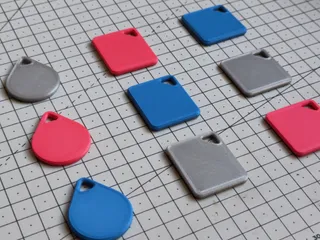MP-1 Rack: Raspberry Pi 2 & 3 2U Rack Mount
Description
PDFOne segment module for the DAP Audio MP-1 10 segments 2U rack frame to mount a Raspberry Pi 2 / 3. It is available in 3 variants with two mounting options each time: screw-in (using M2.5 screw directly in the plastic) and insert (using M2.5 4mm heat-set insert).
The three variants available are:
- simple: just the Raspberry Pi mount
- power: adds support for two 3mm LEDs and a 6x6mm momentary switch
- complete: adds support for an HDMI keystone jack to access the HDMI port from the front
Make sure to download the variant you need from the folder matching your preferred mounting method.
This module is part of a larger collection of modules known as the MP-1 Rack: 2U Modular 19" Racking System collection, which leverages the DAP Audio MP-1 frame to provide custom panel to mount multiple electronic devices such as a ZimaBoard or some keystone modules. Each module in the collection should be compatible with others built by the community.
You can read more about why I built this collection in this article.
Assembly
In order to mount your Raspberry Pi to the module you will need:
- two M2.5x6mm screws
- two M2.5 4mm heat-set insert if you are using the insert version which should be inserted using a soldering iron in the mounting holes
You can then just screw in your Raspberry Pi to the mounting holes using your M2.5 screws.
If you are using the power, or complete variant, you will also need:
- two 3mm LEDs with their respective resistors, in my case I am using:
- a 2.2V 20mA red LED with a 3.3kΩ resistor (to reduce its brightness)
- a 2.2V 20mA yellow LED with a 4.7kΩ resistor (to reduce its brightness)
- a 6x6mm momentary switch with a stem of at least 3mm
Those should be set in place in their respective places in the back of the faceplate and secured with hot-glue if possible (especially important for the momentary switch). They can then be connected to your Raspberry Pi and configured as you which (an example is provided in the Configuration section down below).
Finally, for the complete version, you will want to add:
- one HDMI keystone jack (amazon.com, amazon.co.uk, aliexpress.com)
- a short and slim HDMI cable such as the one used with FPV drones (amazon.com, amazon.co.uk, aliexpress.com)
The keystone jack should just be inserted in its reserved section then connected to your Raspberry Pi using the short HDMI cable.
Configuration
I have set up my own modules as follows:
- Power button: connected between GPIO3 and GND
- Power LED: red LED connected between GPIO17 and GND
- Activity LED: yellow LED connected between GPIO27 and GND
This is then paired with the following /boot/config.txt snippet:
# GPIO3: Button to power on / off
# GPIO17: Power Status LED (pull down when poweroff)
# GPIO27: Activity LED (pull down when poweroff)
dtoverlay=gpio-shutdown,gpio_pin=3,debounce=1000
gpio=17=op,dh
dtparam=act_led_trigger=mmc0
dtoverlay=act-led,activelow=off,gpio=27This snippet configures the gpio-shutdown overlay to use GPIO3 to trigger a clean system shutdown. Here we have to use the GPIO3 pin as it's the only pin capable of restarting the Raspberry Pi once shutdown (see stderr.nl article about the matter).
I have then configured the GPIO17 to be pulled high on boot using the gpio parameter creating a simple power status led.
Finally, the GPIO27 pin is used alongside the act-led overlay to create a configurable activity LED. I have set it up to react to flash storage usage using the act_led_trigger parameter, but it can be configured to use other triggers by update this option.
This configuration was chosen as it doesn't require any software to be run on the Pi and rely solely on existing capabilities from the config.txt file. A more complete write-up about why I decided to use those pins and how to wire it properly is available on my blog.
Printing
The model should be printed with the front section on the build-plate (see the 3mf file) and can be printed relatively quickly and cleanly using 0.3mm layer height in PETG or PLA (PLA might not be the best in warmer environment).
- Raft: no
- Supports: no
- Layer Height: 0.3mm
- Infill: 20%
Changelog
- V1.0 (2022-06-20): Initial release
- V1.0 (2023-04-16): Updated cover picture
- V1.0 (2024-01-10): Remove the mention of Raspberry Pi 4 compatibility
Tags
Model origin
The author marked this model as their own original creation.




